The little fantasy film The Story of Jewel City was made for the 1915 Panama Pacific Exposition in San Francisco.
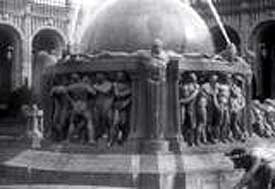 It stars two little girls otherwise unknown to cinema: Kathlyn Dempsey as the Fairy of the Portals, & Catherine Lund as the Little Soldier Fairy. The portal fairy materializes between doric columns by a pond. It stars two little girls otherwise unknown to cinema: Kathlyn Dempsey as the Fairy of the Portals, & Catherine Lund as the Little Soldier Fairy. The portal fairy materializes between doric columns by a pond.
Though it's a children's film, quite surprisingly the Portal Fairy picks some poppies, makes them into a magic drug, & sprinkles the drug over the city, as a blessing. So I guess opium didn't have an entirely bad reputation in 1915 San Francisco.
She then dances all about & scurries through the city where fountains have sprung up & other nice environments of the Panama Pacific Exhibition. One point clearly is that people should attend the Exhibition without fear that the city was still in ruins from earthquakes & fires.
She flies over domes & buildings then comes to another land where a soldier fairy guards a cannon. The soldier fairy walks among the corpses of the slain, baring her sword.
The opium fairy, er, portal fairy brings news of peace, despite that this is 1915 & war was in full sway in Europe. The soldier fairy flies to the beautiful city of the Exhibition & they kiss each other.
Together they open the Portals to the World & everyone comes to the exhibition, though we don't see anyone. "Noted men give welcome" the dialogue card informs us, but we don't see them either. The word "Peace" appears on the screen & it's all over, ignoring that the opening of the Canal fascilitated rather than ended the World War.
This primitive film is foolish & amateur even for the day, but I like even foolish old silent movies so it was great for me.
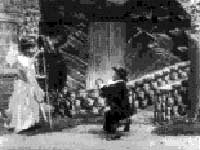 Possibly America's first important director, Edwin S. Porter worked for Edison Manufacturing at the start of the film age. Possibly America's first important director, Edwin S. Porter worked for Edison Manufacturing at the start of the film age.
Porter's range during the "primitive" era of filmmaking was startling & a lot of what one might've thought would take at least a decade of filmmaking to be discovered was lit upon by Melies in France & Porter in America almost at once, though to be sure Porter was more influenced by Melies than the reverse.
Jack & the Beanstalk (1902) is practically epic at nine minutes, for even at this early date movies have developed clear narrative form & special FX. On a wonderfully designed set with bridge, house, & waterfall, a fairy woman materializes & gives a traveller magic beans.
Jack encounters the same traveler who trades the beans for Jack's cow. The cow itself is a delight in this scene. Jack skips home to another lovely set & his mom tosses the beans into a compost pile, disappointed in her gullible son.
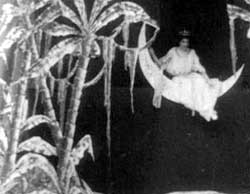 That night the fairy reappears & the beanstalk grows speedily. The fairy also appears in Jack's room to perform a bit of hallucinatory magic before ever he sees the beanstalk. That night the fairy reappears & the beanstalk grows speedily. The fairy also appears in Jack's room to perform a bit of hallucinatory magic before ever he sees the beanstalk.
Rising from bed & hurrying outside, up the stalk goes Jack. The story procedes as the well-known version, although the recurring fairy adds a bit extra. There's no giant per se, but a hunter in the sky who doesn't seem all that bad a fellow.
There's a magic chicken, but the harp looks like its carved out of a piece of cardboard so Jack the thief leaves that behind.
Taking only the chicken & the hunter's bags of gold, Jack follows his initial crime with a worse one, murdering the rightful owner of the chicken & gold by cutting down the beanstalk. The fairy gives Jack & his mom rich clothing & the moral is "Crime Pays." Or so it seems to me.
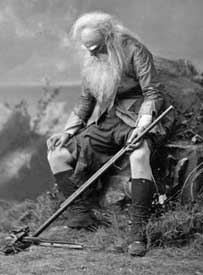 An even earlier fantasy film featured Joseph Jefferson in the starring role as Rip Van Winkle (1896). This was a role the comic actor had already been playing for thirty years, & for which he was long famous well before this "flip card" movie was made. An even earlier fantasy film featured Joseph Jefferson in the starring role as Rip Van Winkle (1896). This was a role the comic actor had already been playing for thirty years, & for which he was long famous well before this "flip card" movie was made.
At approximately four minutes, it opens with "Rip's Toast" to establish that Rip has already been drinking as the story begins. We then see him walking in the mountains with his musket when a dwarf with a beer barrel happens by, weary from his load.
The dwarf convinces Rip to carry the barrel for him, & leads him to a holler where he meets a whole tribe of dwarfs.
Rip is soon ripped as the little bearded chaps share their magic brew. Twenty years later he wakes from his binge, long-bearded, his clothes rotted on his body, & in need of a staff to even walk.
This extreme condensation of part of the tale is broken into several separately titled half-minute chapters. In 1898 they were each intended to be played separately on flip-cards in a mutoscope. The 1902 date seen on the modern restoration as a single film derives from the copyright date, the film having been around a few years before it was belatedly filed for copyright when combined into one film.
This is of course the first film interpretation of the classic story by Washington Irving. It stands among the earliest "plotted" films as opposed to the dances & moving trains & bland street scenes & dining room scenes & such which dominated in the first wave of moving pictures, when the mere fact of motion seemed enough to justify each wee production.
The director though uncredited was William K. L. Dickson, whose films tended mainly to be half-minute pictorials or vaudeville acts. He was definitely not noted for plotting his short-shorts, & the leap in substantive content for Rip Van Winkle is probably accidental for Dickson, being only what the well-reputed actor wanted to do.
copyright © by Paghat the Ratgirl
|
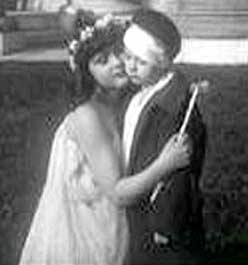
 It stars two little girls otherwise unknown to cinema: Kathlyn Dempsey as the Fairy of the Portals, & Catherine Lund as the Little Soldier Fairy. The portal fairy materializes between doric columns by a pond.
It stars two little girls otherwise unknown to cinema: Kathlyn Dempsey as the Fairy of the Portals, & Catherine Lund as the Little Soldier Fairy. The portal fairy materializes between doric columns by a pond.
 That night the fairy reappears & the beanstalk grows speedily. The fairy also appears in Jack's room to perform a bit of hallucinatory magic before ever he sees the beanstalk.
That night the fairy reappears & the beanstalk grows speedily. The fairy also appears in Jack's room to perform a bit of hallucinatory magic before ever he sees the beanstalk.